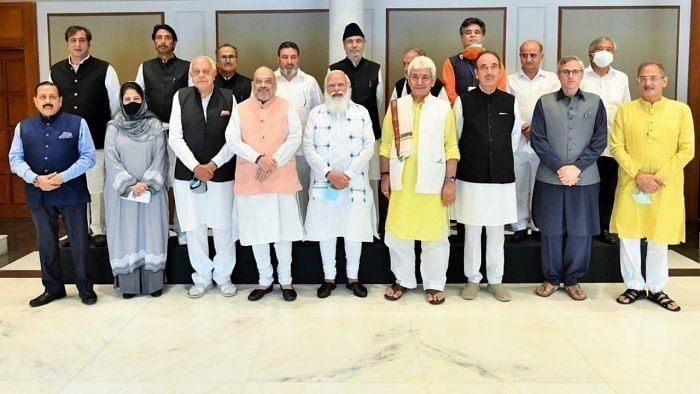
After the recent meeting of J&K politicians with Prime Minister Narendra Modi in New Delhi, the delimitation of Assembly constituencies has emerged as the first step to restoring the democratic process in the Union Territory (UT). J&K has been under central rule since June 2018, when the BJP withdrew from its coalition government with the PDP. Though since then panchayat, local body, parliament and district development council (DDC) polls have been held in the region, the BJP-led central government has not conducted Assembly elections in the erstwhile state.
In April 2019, the Election Commission decided not to hold Assembly polls along with parliamentary elections in J&K due to “security reasons.” However, after the scrapping of the special status of J&K under Article 370 and bifurcation of the erstwhile state into two UTs, the Government of India has been constantly saying that the polls would be held only after the delimitation exercise is completed. And at the June 24 meeting, the Prime Minister assured the Kashmiri leaders that his government was in favour of holding early Assembly elections and restoring J&K’s statehood, but with a rider: delimitation exercise first.
After the PM’s meeting, the delimitation commission has expedited its work and its members are visiting the UT from July 6 to July 9 to gather “first-hand” inputs on the ongoing process. During the visit, the commission’s members are expected to hold talks with various political parties and also the five associate members who are the five Lok Sabha MPs from the UT.
Delimitation is the act of redrawing boundaries of an Assembly or Lok Sabha seat to represent changes in population over time. In March last year, the Centre had notified the constitution of the delimitation commission headed by former Supreme Court judge Ranjana Desai to redraw the Assembly and parliamentary constituencies of J&K as per the J&K Reorganisation Act, 2019. The commission got a one-year extension in March this year, as it couldn’t complete the exercise, apparently due to the Covid-19 pandemic.
Assembly seats in J&K were delimited in 1963, 1973 and 1995. The last delimitation exercise was conducted in J&K under President’s Rule in 1995 by a panel headed by former judge K K Gupta. The next exercise was due in 2005, but in 2002, the then state government chose to freeze delimitation until after 2026 by amending the Jammu & Kashmir Representation of the People Act, 1957, and Section 47(3) of the Constitution of Jammu & Kashmir. The decision was in line with the pan-India freeze on delimitation of Lok Sabha constituencies till the first census after 2026.
As the August 5, 2019, decision annulled J&K’s constitution, the freeze on delimitation till 2026 also became irrelevant. In fact, the J&K Reorganisation Act, which came into force on October 31, 2019, mandates delimitation of constituencies in the UT. However, in Kashmir, questions are being raised over the timing of the latest exercise. There is a fear in Muslim-majority Kashmir that it will be skewed in favour of Hindu-majority Jammu region where the BJP emerged as the single largest party in the 2014 Assembly election, securing 25 seats (out of 37).
According to the last census (2011), the population of erstwhile J&K state was 12.5 million, with 6.89 million in Kashmir and 5.38 million in Jammu (Ladakh accounted for 274,289 people). This provided 46 seats to Kashmir, 37 to Jammu and four to Ladakh in the 87-member J&K Assembly, and 24 seats were reserved for Pakistan-Occupied Kashmir.
However, some parties, including the BJP, have been arguing that in terms of geographical area, Jammu is about 26,293 sq km while Kashmir is 15,948 sq km and thus the fresh delimitation needs to take into account not only the population, but geographical area as well. And if the latest grapevine in the Valley is to be believed, the commission is going to increase Assembly seats of Jammu from 37 to 44 and in Kashmir from 46 to 48. The delimitation exercise will also lead to a number of reserved constituencies based on Scheduled Caste and Scheduled Tribe settlements and will further tilt the balance in favour of Jammu.
Kashmiri politicians argue that if the delimitation commission for Assam could be withheld and Assembly elections held there, then why not for J&K. They also demand restoration of statehood before Assembly polls are held. However, while they had earlier boycotted the meetings of the commission— calling the exercise “palpably unconstitutional”— several of them have now agreed to engage with the process. If the regional National Conference, PDP and other Valley-based political parties participate in the delimitation exercise, it will be the first sign from them of their acceptance of the post-August 5, 2019, reality of J&K. The NC and the CPI (M) have challenged in the Supreme Court the constitutionality of the 2019 Reorganisation Act that nullified J&K’s statehood and created two UTs. If they accept the PM’s roadmap of delimitation before polls, they will be abandoning their position.
And if Jammu region gains more seats in the delimitation process, it may pave way for the fulfillment of the long-term ambition of BJP of having a Hindu chief minister in Muslim-majority J&K. According to the 2011 census, Muslims constitute 68.31% of the total population of the erstwhile state, the majority of which lives in Kashmir and in the Muslim belts of Jammu region. Hindus, who are mostly concentrated in four districts of Jammu, constitute 28.44% of the population. If the BJP succeeds in its plan to have a Hindu chief minister in the only Muslim majority state of the country, it will reap huge dividends for itself in the 2024 Parliament elections across India.